With cheer-bringing blossoms on bare stems in the dead of winter, the flowering quince is an ancient Chinese symbol of an auspicious New Year. At least as cheering to me would be seeing a Big 10 football team lose the Rose Bowl to a California team (go Stanford), and I can think of many other favorite California plants that make a statement that winter is no time to shut down.
It's hard to miss the bold splotches of early camellias, pink clouds of purple-leaf plum, pure white evergreen pear, spiky red aloes on the Santa Barbara and Orange County coasts, and other January performers. The best sight of all to me is this winter's already green hills, at least in Northern California, which suggest that we should have a decent amount of water this year. The green hills also say it's time to start planting and pruning again — welcome, January jobs.
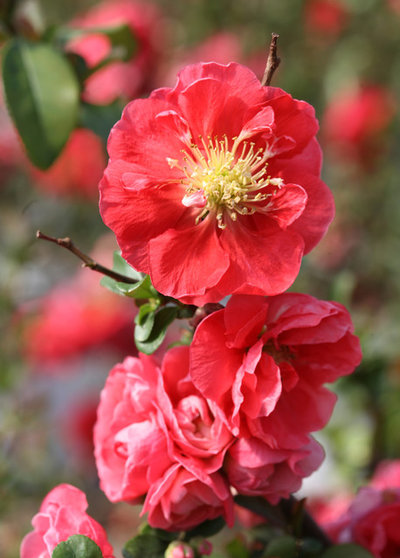
Monrovia
Brighten your garden or home. Flowering quince is one of the first plants to bloom every year — especially prized because the bare stems loaded with buds open so freely when brought indoors.
There are many, many varieties, old and new, with single or double flowers, white, pink, orange, red. An old-time red is a fixture in many rural communities, a testament to its ability to survive with little care.
'Pink Storm', shown here, is a new variety with double, bright pink flowers.
Botanical name: Chaenomeles speciosa 'Pink Storm'
USDA zones: 5 to 8 (find your zone)
Water requirement: Moderate
Light requirement: Full sun to partial shade
Mature size: 4 feet tall and wide, and larger
Growing tips: To control the size and shape, prune after bloom or during the budding and blooming stage. To display blooms indoors, cut budding stems and put them near a sunny window.
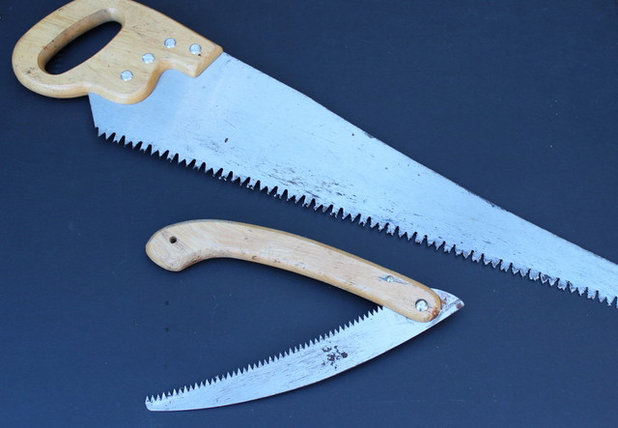 The tools of winter.
The tools of winter. Few gardening projects are more satisfying than pruning leafless trees and shrubs on a brisk but sunny January day in California. One essential tool is a pruning saw. A good one will last longer than some of the trees in your garden, and you'll find uses for it all year.
Years ago I was told not to cut trees with a carpenter's saw — it's bad for the tool and the tree, and probably for the person doing the cutting. Pruning saws have coarser teeth designed to cut moist, sappy wood. They are often curved, which gives them a cool look, and the blades cut when you pull, not on the push stroke.
Shown here are a couple of my venerable, much-used saws. Folding models are lightweight and easy to carry — fine for small limbs. For branches an inch or two thick, better get a full-size model of decent quality, generally $50 and up. For larger branches call in a chain saw.
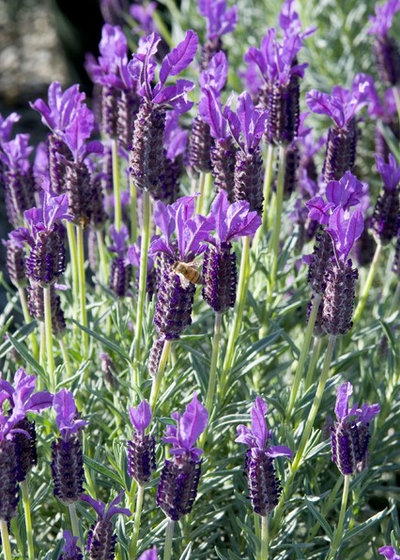
Monrovia
Hot stuff. Just as business writers pick their hot stocks for the upcoming year (invest at your own peril), people who write about gardening talk about hot new plants. The focus usually is on roses and annuals, whether or not new roses or annuals are really wanted.
I like to talk about new plants that I have actually seen and that I'd like to grow if I had the room.
I saw a number of such plants at the 2012 conference of the American Society of Landscape Architects in Phoenix.
Here are a few that caught my eye — new to me, if not really new.
Spanish lavender, shown here, blooms early, and the deep purple flowers last long. It's nice in borders or massed on a slope.
Botanical name: Lavandula stoechas 'Winter Bee'
USDA zones: 7 to 10
Water requirement: Moderate; needs more in hot climates
Light requirement: Full sun
Mature size: 2 feet tall and wide
Growing tips: Can be sheared for a more formal look. Produces seeds heavily, which can spread where they're not wanted.
More about lavender
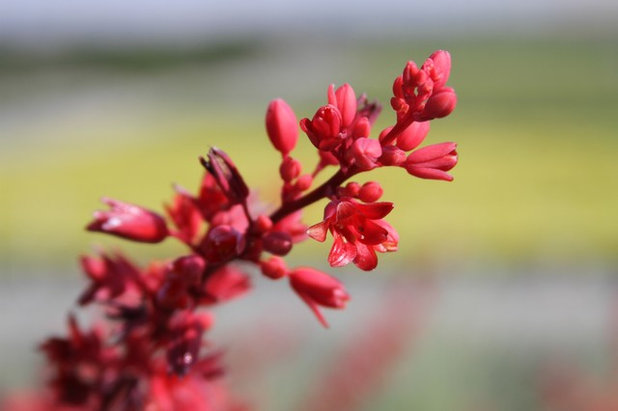
Monrovia
'Brakelights' Red Yucca also looked great to me in Phoenix, not far from where it
originated with Mountain States Nursery, a pioneer at introducing native desert plants to the West. It's a compact, spiky plant, vibrantly colored. Plant it in masses or in a container.
Botanical name: Hesperaloe parvifolia 'Brakelights' or
'Perpa'
USDA zones: 5 to 10
Water requirement: Light; considered drought tolerant; water regularly during the first season
Light requirement: Full sun
Mature size: 2 feet tall and wide
Growing tips: Needs fast drainage
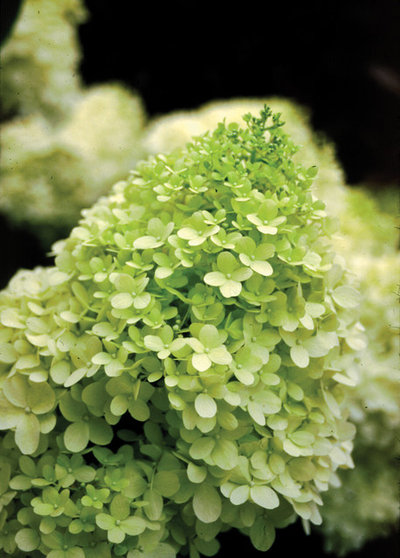
Monrovia
‘Limelight’ hardy hydrangea is another newcomer, a big shrub, much larger than the typical hydrangea. It’s prized by people who like green flowers. These are chartreuse and grow in big clusters.
Botanical name: Hydrangea paniculata ‘Limelight’
USDA zones: 3 to 8
Water requirement: Moderate; water more often in hot climates
Light requirement: Partial shade
Mature size: 8 feet tall and wide
Growing tips: Prune it in the dormant season to control size.
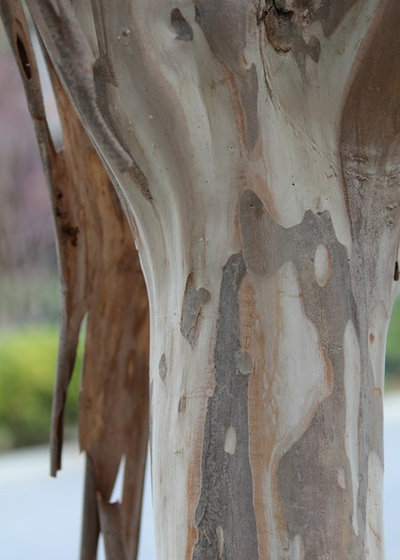 Bark as art.
Bark as art. With trees leafless and the sun low in the sky, some less flashy plant attributes come clearly into view — such as tree bark. Keep your eyes open for unexpected beauty in your garden or wherever you wander in winter.
For instance, crape myrtle, shown here, is known for vibrant summer flowers, but its mottled, sometimes gleaming winter bark is pretty in its own right. Near my house I look for California sycamore
(Platanus racemosa) and Catalina ironwood
(Lyonothamnus asplenfolius). Even the notorious
Eucalyptus globulus, scourge of the California countryside, has beautiful bark — just don't plant a tree to get a view of it.

Designing California Native Gardens
Designing or redesigning a garden? There are tons of books on how to design gardens, many of the best coming from England with little relevance to California — unless you have sheep grazing on your front meadow.
If you are thinking of a major garden design or redesign project this year, here are a few with a helpfully specific California focus:
• Designing California Native Gardens, by Glenn Keator and Alrie Middlebrook. Takes a deep look at using native plants in both artful and practical ways. But I have to say I'm not a fan of the drawings intended to help visualize the three-dimensional views of a garden.
• Big Book of Garden Designs, by Marianne Lipanovich (a Houzz contributor) and Tom Wilhite. A Sunset Publishing book that includes 120 practical plans for a wide range of landscape situations.
• Sunset Western Landscaping, edited by Kathleen Brenzel. Intended as a companion to the
Western Garden Book, this hefty 416-pager includes hundreds of photos as inspiration along with helpful nitty-gritty details on plant selection, design of beds, paths and other landscape basics.
• Growing California Native Plants (second edition, expanded and updated), by Marjorie G. Schmidt and Katherine L. Greenberg. Not really a design book but indispensable if you want to grow natives successfully in your landscape.
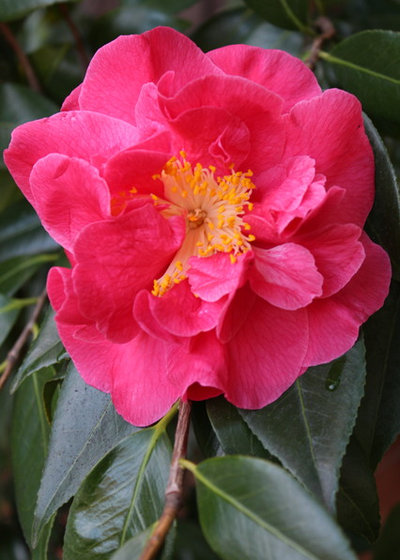 What else to do in January in your California garden.
What else to do in January in your California garden. There are plenty of things to do if the weather alllows, including traditional midwinter pruning, cleanup and even some planting.
Care for camellias. Freely cut early-blooming camellia blooms (such as 'Guilio Nuccio', shown) to bring indoors. Make cuts above new leaf buds to encourage bushy growth. Pick up fallen blossoms to stop the spread of the disease called petal blight.
Move living Christmas trees outside. Make sure the root ball of a container-grown tree hasn’t dried out (test by probing it with your fingers); give it a soaking to be sure. Don’t plant the tree in the ground yet if the soil is too soggy.
Keep gift plants blooming. Give them a spot in a sunny window.
Brighten your garden. Set out cool-season annuals now available blooming in small pots: calendulas, Iceland poppies, pansies, snapdragons, stock, violas and others. Plant them in sunny garden beds or containers.
Start vegetable seeds indoors. Seedlings should be ready to go into the ground in six to eight weeks. Here are easy crops to try: Brussels sprouts, cabbage and cauliflower.
Plant summer bulbs. These work especially well in warmer climates like Southern California's: flashy begonias, reliable cannas and flamboyant tigridias.
Prune roses. This is the optimum time, even though some roses may still be blooming. As a general guideline, cut plants back by about a third and leave three to five canes sprouting from the base. Remember that pruning varies by type of rose.
Get bare-root plants in the ground. If the soil is dry enough, put in bare-root plants, such as fruit trees, berries, shade trees, roses and many other plants. Get preplanting advice from a nursery or garden center on how much to cut back roots and other care.
Prune deciduous fruit trees and shade trees. The best time is when trees are dormant and leafless. Make sure your shears are sharp. Wait until spring-flowering shrubs and trees (such as lilacs) have finished blooming before pruning them.
More guides to California gardening on Houzz





